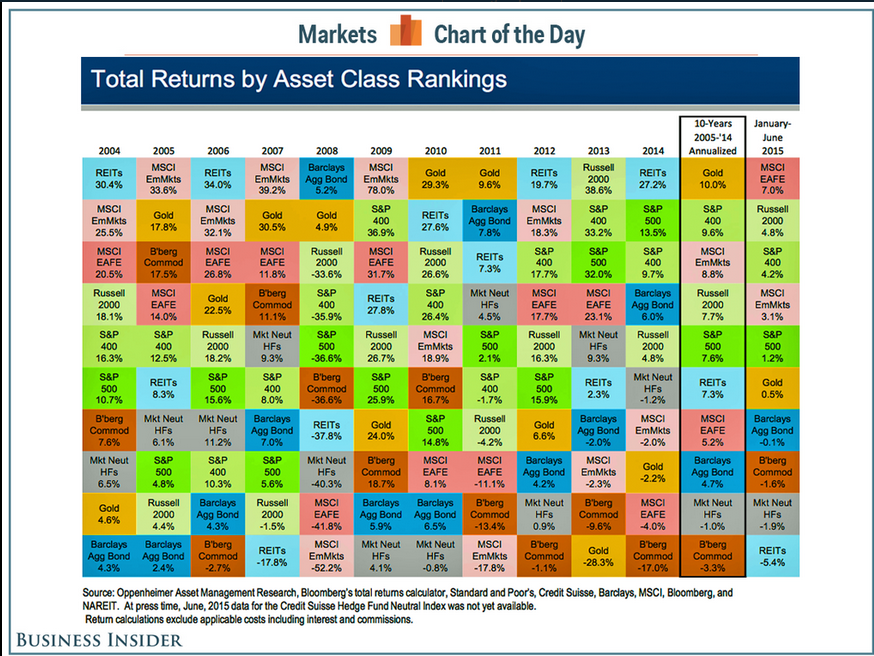In 2014 I managed to avoid the Energy sector for clients almost entirely, by owning no Energy (crude oil or natural gas) companies and selling Halliburton (NYSE:HAL) near $70 during the summer of 2014.
Unfortunately, like a golfer that eagles one hole, and then takes a 9 on a par 3, our Basic Materials holdings for clients coming into and out of the summer of 2014 were:
- a.) Alcoa (NYSE:AA) [aluminum]
- b.) US Steel (NYSE:X [steel]
- c.) Freeport-McMoran Copper & Gold (NYSE:FCX) [Copper and Energy]
- d.) Peabody Energy (NYSE:BTU) [for the granddaddy of all disasters, coal]
Here is what piqued my interest in the group and kept me long the names for so long:

Although I haven’t owned gold for clients since late 2011, Commodities and Gold have been at the bottom of the “asset class return” table for three years running, i.e. 2012, through 2014, and managed to move up one slot through the first 6 months of 2015.Today, gold is getting killed again.
When I think of the “reversion to the mean” trade currently, the old saying “timing is everything” still matters too.
1.) The dollar is stronger once again over the past few weeks, breaking the downtrend line in place since mid-March ’15, which is a negative for gold and commodities.
2.) China is a mess both insofar as producing a LOT of its commodities and given the supposed slower growth, which means they're likely consuming less too.
3.) I’ve always felt that the commodity complex and the emerging markets, given their commodity-based economies, seemed to be closely correlated, and right now the iShares MSCI Emerging Markets ETF (ARCA:EEM) looks ready to roll over again and trade down to $35.
We were long some of the base metals companies for clients, waiting for a “return-to-global-growth” theme, and the trade didn’t work.
Looking at the past 35 years, from 1980 through 2015, the only time these stocks worked for a decent period of time was during the early 2000s through 2007, when China was growing 15% per year.
- US Steel traded up to $180 by mid 2008 and promptly came right back down.
- Peabody Energy traded up to $82 and is now $1.50 per share.
- Freeport Copper traded as high as $62 in mid-2008.
Basic Materials, of which Chemicals is the largest weighting at 70% – 75% of the sector, is just 3% of the S&P 500 by market cap and earnings weight, so these base metals companies are a pretty small component of the overall index.
Next time, I do think we will eliminate the operating risk of commodity companies, and stick with pure-play commodity ETFs, like we did with SPDR Gold Shares Fund (ARCA:GLD). In the early 2000s, when gold bottomed right when the tech and growth stock bubble peaked, the only way investors could get exposure to gold was to buy Newmont Mining (NYSE:NEM) or other gold miners. When the GLD ETF was launched in late 2005, it was a much better way (in my opinion) to play gold than the operating companies.
If readers have a favorite commodity ETF that you think is worth mentioning, please note it in the comments and I’ll give it a look.
Given the asset class returns table (above and in the link provided), “relative” investors can’t ignore the commodity complex.
